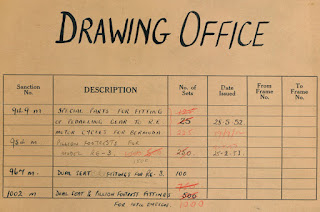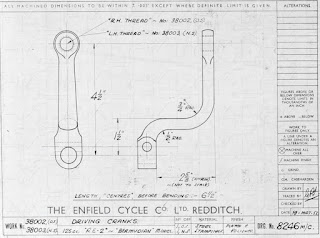 |
| Photograph of the Royal Enfield Bermudian. |
Royal Enfield came very close to producing a special motorcycle, equipped with bicycle pedals, in 1952. At least one prototype, or mock up of this moped was built. Photos of it exist.
How close the pedal-assisted Royal Enfield actually came to production is revealed in documents Allan Hitchcock of Hitchcocks Motorcycles found in the factory records the firm owns.
These records give the motorcycle the name "Bermudian." It was designed especially to be sold on the islands of Bermuda, where laws once required motorized two-wheelers to be equipped with pedals.
The little motorcycle was a variation of the Royal Enfield Model RE2 two-stroke. This was an improved and civilianized version of the famous Royal Enfield Flying Flea, built during World War II to be dropped by parachute.
In fact, factory records show that in 1952 Royal Enfield did send Model RE2 motorcycles to Bermuda. But were these equipped with pedals?
No one I could reach in Bermuda recalls seeing any such thing, and period advertisements that appeared in Bermuda show ordinary Royal Enfield RE2s, with no pedals visible.
The illustrations in those ads may be incorrect, of course. But I think the regulation requiring pedals simply went away and ordinary Royal Enfields were delivered instead.
There is a story that motorcyclists in Bermuda were attaching phony pedals to their standard machines, to evade the law, and one such modification led to a fatal crash, causing the regulation to be dropped.
Bermuda's Motor-Cycles and Auxiliary Bicycles (Special Measures of Control) Act 1953 doesn't explicitly deal with pedal power, but it gives authorities the power to change the rules. The timing seems just about right to have eliminated the need for a pedal-assisted Royal Enfield for Bermuda.
The Hitchcocks documents seem to show that Royal Enfield had been in fact gearing up for production.
 |
| Royal Enfield Drawing Office prepared for 225 pedal-assisted RE2s. |
A Royal Enfield "Drawing Office" cover sheet lists Sanction No. 949m, "Special Parts for Fitting of Pedalling Gear to R.E. Motor Cycles for Bermuda." Next to the date Sept. 19, 1952 appears the notation "No. of Sets 225."
Two-hundred and twenty-five!
Inside, on the list of "Parts Required to Add Pedal Drive" for the "RE2 Bermudian," the number 225 sets again appears.
 |
| 225 sets of special parts would be needed for the Bermudian. |
A second sheet of "Parts Required in Conjunction With Pedal Drive" seems to show "No. of Sets: 2." Seeing this, sharp-eyed Royal Enfield enthusiast Chris Overton pointed out to me that it's actually, very faintly, not 2 but "225."
| For some reason the number "225" is hard to see, but it's there. |
A separate engineering drawing found by Allan shows "Driving Cranks" for the "RE2 Bermudian Model." The pedaling cranks could not be normal, straight, bicycle types; they would need a special bend outward to clear the unit motor and gearbox of the RE2.
 |
| Factory drawing shows Royal Enfield was planning a moped. |
Pedaling the Royal Enfield Bermudian moped would have been awkward, no doubt. The special parts needed to produce a few hundred motorcycles would have made it expensive, affecting the profit to be made.
If there was no legal need to produce the special version to sell in Bermuda, naturally it would be dropped.
And that's probably what happened.
Of course I would be delighted to be proven wrong. Does the pedal-pusher Royal Enfield Bermudian (at least the prototype) still exist? If you know, please contact me.































No comments:
Post a Comment